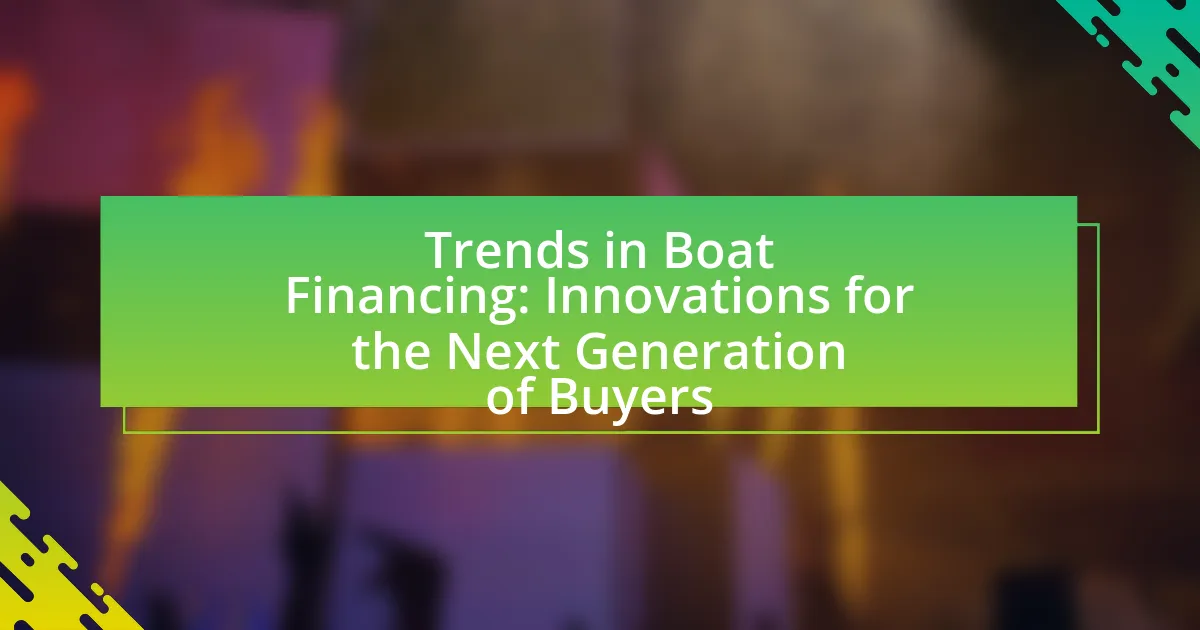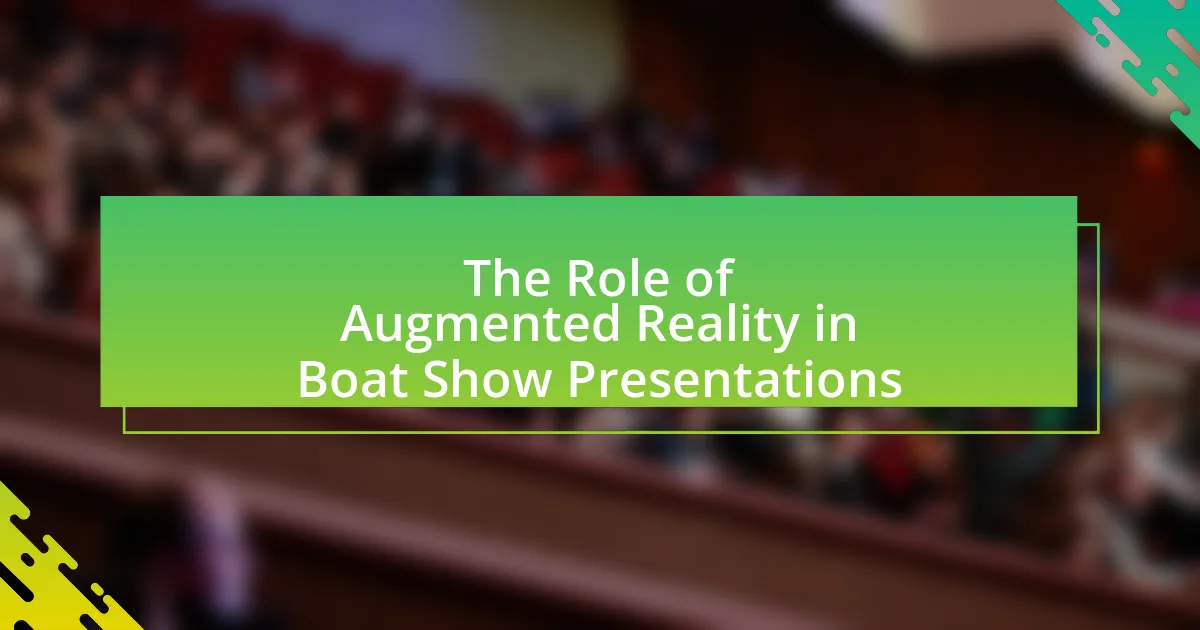Hybrid boats are vessels that combine traditional fuel engines with electric propulsion systems, offering a more environmentally friendly alternative to conventional boats. This article explores the significance of hybrid boats in reducing emissions and fuel consumption, highlighting their potential to decrease greenhouse gas emissions by up to 30%. It examines the technological advancements that enhance energy efficiency, the environmental benefits of reduced emissions, and the impact on marine ecosystems. Additionally, the article discusses current trends in hybrid boat technology, including battery innovations, automation, and design considerations, while addressing the challenges and economic factors influencing their adoption in the maritime industry.
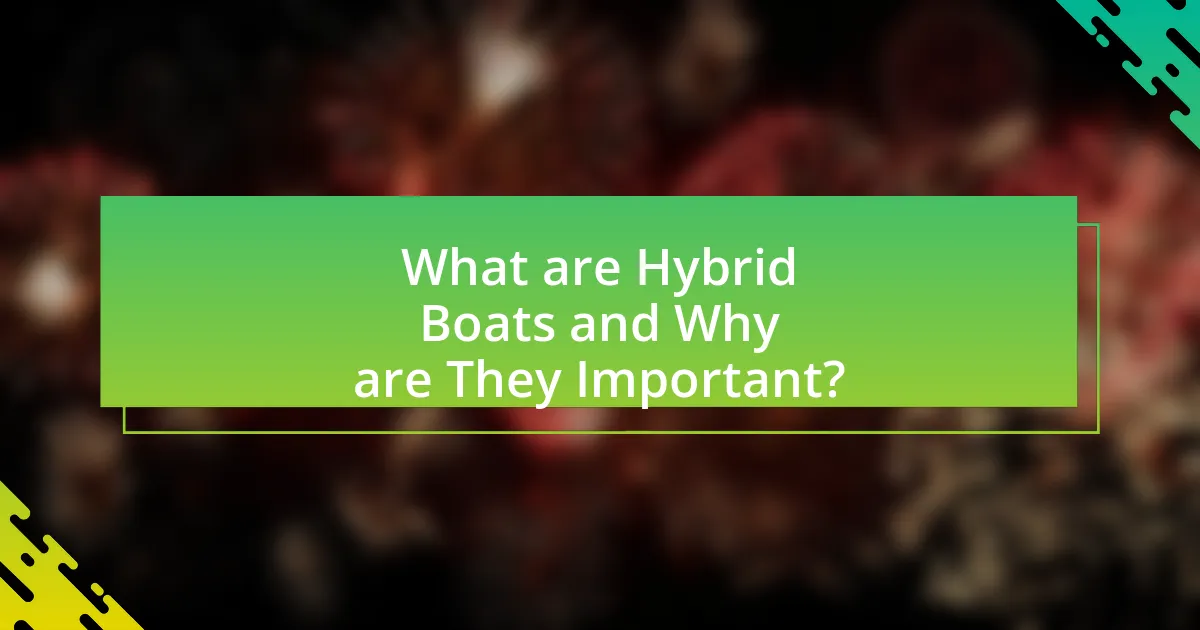
What are Hybrid Boats and Why are They Important?
Hybrid boats are vessels that utilize both traditional fuel engines and electric propulsion systems to operate. They are important because they offer a more environmentally friendly alternative to conventional boats, reducing emissions and fuel consumption. According to a study by the International Maritime Organization, hybrid technology can decrease greenhouse gas emissions by up to 30% compared to traditional marine engines. This shift towards hybrid boats aligns with global efforts to promote sustainable practices in the maritime industry, making them a crucial component in the transition to greener boating solutions.
How do Hybrid Boats differ from Traditional Boats?
Hybrid boats differ from traditional boats primarily in their propulsion systems, as hybrid boats utilize both an internal combustion engine and electric motors, while traditional boats typically rely solely on internal combustion engines. This dual propulsion system in hybrid boats allows for greater fuel efficiency and reduced emissions, aligning with environmental regulations and sustainability trends. For instance, hybrid boats can operate on electric power at lower speeds, minimizing fuel consumption and noise, which is particularly beneficial in sensitive marine environments. Additionally, advancements in battery technology and energy management systems enhance the operational capabilities of hybrid boats, making them more versatile compared to their traditional counterparts.
What technologies are used in Hybrid Boats?
Hybrid boats utilize a combination of technologies, primarily electric propulsion systems and traditional internal combustion engines. Electric motors provide efficient and quiet operation, while internal combustion engines offer extended range and power when needed. Additionally, hybrid boats often incorporate advanced battery management systems to optimize energy use and regenerative braking technology to recharge batteries during operation. These technologies enhance fuel efficiency and reduce emissions, aligning with environmental regulations and consumer demand for sustainable boating solutions.
How do Hybrid Boats achieve energy efficiency?
Hybrid boats achieve energy efficiency by combining traditional fuel engines with electric propulsion systems, allowing for optimized fuel consumption and reduced emissions. This dual system enables the boat to operate on electric power at lower speeds, which is more efficient, while the combustion engine can be utilized for higher speeds or when additional power is needed. According to a study by the International Maritime Organization, hybrid systems can reduce fuel consumption by up to 30% compared to conventional vessels, demonstrating their effectiveness in enhancing energy efficiency.
What are the environmental benefits of Hybrid Boats?
Hybrid boats significantly reduce environmental impact by combining traditional fuel engines with electric propulsion systems, leading to lower emissions and decreased fuel consumption. This dual system allows for cleaner operation, especially in sensitive marine environments, as electric power can be utilized in areas where emissions are restricted. Studies indicate that hybrid boats can reduce greenhouse gas emissions by up to 50% compared to conventional boats, contributing to improved air quality and reduced ocean pollution. Additionally, the use of regenerative braking in hybrid systems can enhance energy efficiency, further minimizing the ecological footprint of marine activities.
How do Hybrid Boats reduce emissions?
Hybrid boats reduce emissions by utilizing a combination of traditional fuel engines and electric propulsion systems, which allows for more efficient energy use. This dual system enables hybrid boats to operate on electric power at lower speeds or during idle periods, significantly decreasing fuel consumption and harmful emissions. According to a study by the International Maritime Organization, hybrid vessels can reduce greenhouse gas emissions by up to 30% compared to conventional boats, demonstrating their effectiveness in promoting cleaner marine transportation.
What impact do Hybrid Boats have on marine ecosystems?
Hybrid boats have a positive impact on marine ecosystems by reducing emissions and minimizing noise pollution. These vessels typically utilize a combination of electric and traditional fuel engines, which leads to lower greenhouse gas emissions compared to conventional boats. For instance, a study by the International Maritime Organization indicates that hybrid technology can reduce carbon dioxide emissions by up to 30%. Additionally, the quieter operation of hybrid boats helps to protect marine wildlife, as many species are sensitive to noise pollution, which can disrupt their communication and breeding patterns. Therefore, the adoption of hybrid boats contributes to healthier marine environments by promoting sustainability and reducing harmful impacts.
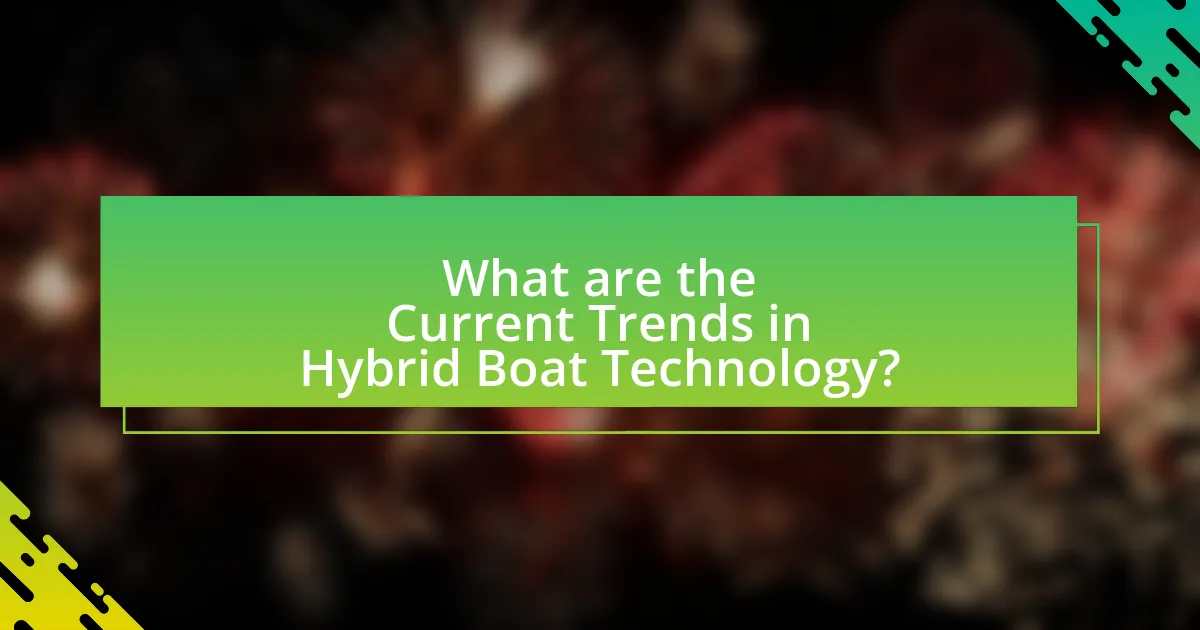
What are the Current Trends in Hybrid Boat Technology?
Current trends in hybrid boat technology include the integration of advanced battery systems, increased use of renewable energy sources, and the development of more efficient propulsion systems. Advanced battery systems, such as lithium-ion and solid-state batteries, enhance energy storage and reduce weight, allowing for longer operational ranges. The use of renewable energy sources, like solar panels and wind turbines, is becoming more prevalent, enabling boats to operate with minimal environmental impact. Additionally, manufacturers are focusing on hybrid propulsion systems that combine traditional engines with electric motors, improving fuel efficiency and reducing emissions. These trends reflect a growing commitment to sustainability and innovation in the maritime industry.
How is battery technology evolving for Hybrid Boats?
Battery technology for hybrid boats is evolving through advancements in energy density, charging speed, and lifecycle management. Recent developments include the use of lithium-sulfur and solid-state batteries, which offer higher energy densities compared to traditional lithium-ion batteries, enabling longer operational ranges for hybrid vessels. Additionally, innovations in fast-charging technology are reducing downtime, allowing for quicker recharges during operations. According to a report by the International Council on Clean Transportation, the energy density of lithium-sulfur batteries can reach up to 500 Wh/kg, significantly improving the efficiency of hybrid systems. These advancements are crucial for enhancing the performance and sustainability of hybrid boats in the maritime industry.
What advancements are being made in energy storage solutions?
Advancements in energy storage solutions include the development of solid-state batteries, which offer higher energy density and improved safety compared to traditional lithium-ion batteries. Research indicates that solid-state batteries can potentially double the energy capacity while reducing the risk of fire hazards, as demonstrated by companies like QuantumScape, which reported a prototype with over 400 Wh/kg energy density. Additionally, advancements in flow batteries are enhancing scalability and longevity, with systems like vanadium redox flow batteries showing the ability to cycle for over 10,000 times without significant degradation. These innovations are crucial for hybrid boats, as they enable longer operational ranges and faster charging times, aligning with the growing demand for sustainable marine solutions.
How do these advancements affect boat performance?
Advancements in hybrid boat technology significantly enhance boat performance by improving fuel efficiency, reducing emissions, and increasing speed. Hybrid systems combine traditional engines with electric propulsion, allowing for optimized power usage. For instance, a study by the National Renewable Energy Laboratory found that hybrid boats can achieve up to 30% better fuel efficiency compared to conventional boats, which directly translates to longer operational ranges and lower operational costs. Additionally, advancements in battery technology enable faster charging and longer-lasting power, further enhancing overall performance and sustainability in marine operations.
What role does automation play in Hybrid Boats?
Automation plays a crucial role in hybrid boats by enhancing operational efficiency and safety. It enables the integration of advanced control systems that manage power distribution between the electric and combustion engines, optimizing fuel consumption and reducing emissions. For instance, automated systems can adjust engine performance based on real-time data, ensuring that the boat operates at peak efficiency under varying conditions. This capability not only improves the environmental footprint of hybrid boats but also contributes to smoother navigation and reduced crew workload, as evidenced by the increasing adoption of automated technologies in marine engineering.
How are smart technologies integrated into Hybrid Boats?
Smart technologies are integrated into hybrid boats through advanced systems that enhance navigation, energy management, and user experience. These systems include GPS-based navigation aids, automated engine controls, and real-time monitoring of energy consumption, which optimize performance and fuel efficiency. For instance, hybrid boats often utilize smart sensors that collect data on battery levels and fuel usage, allowing for efficient switching between electric and combustion engines. Additionally, integration with mobile applications enables users to monitor and control various functions remotely, improving convenience and safety. This integration of smart technologies is supported by the growing trend of digitalization in the marine industry, which aims to enhance operational efficiency and reduce environmental impact.
What benefits do automated systems provide to boaters?
Automated systems provide boaters with enhanced safety, improved navigation, and increased efficiency. These systems, such as autopilot and collision avoidance technologies, reduce the risk of human error, which is a leading cause of maritime accidents. For instance, studies indicate that automated navigation systems can decrease the likelihood of collisions by up to 30%. Additionally, automated systems streamline operations, allowing boaters to focus on other critical tasks, thereby improving overall boating experience and performance.
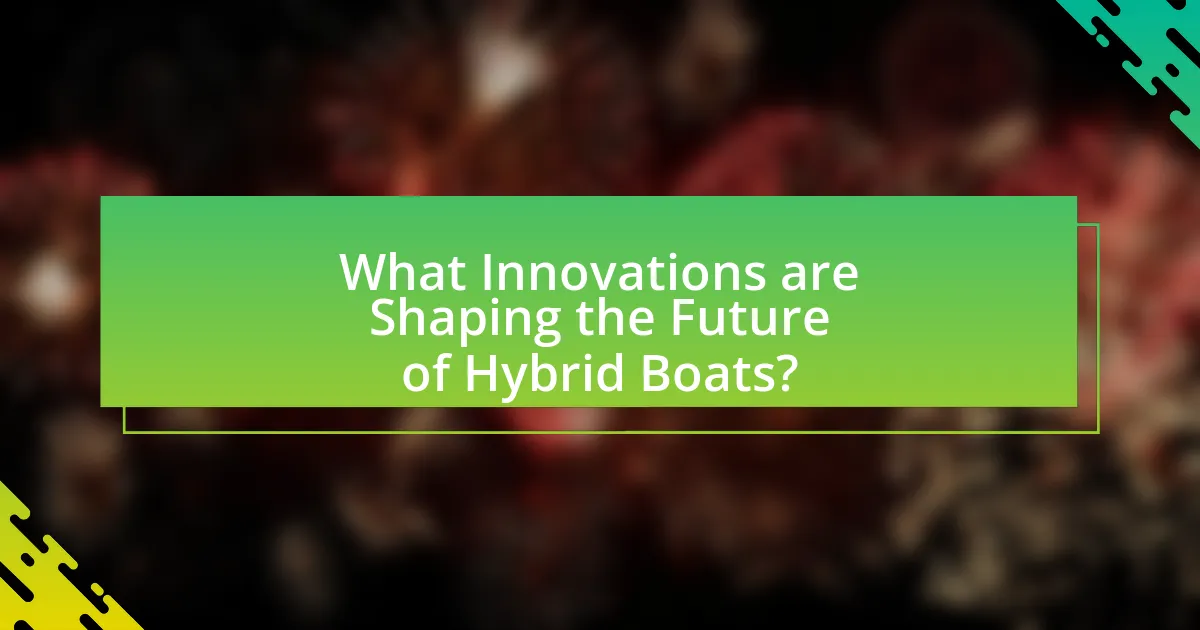
What Innovations are Shaping the Future of Hybrid Boats?
Innovations shaping the future of hybrid boats include advancements in battery technology, integration of renewable energy sources, and improvements in propulsion systems. Enhanced lithium-ion batteries are providing longer ranges and faster charging times, making hybrid boats more efficient. Additionally, the incorporation of solar panels and wind turbines allows for cleaner energy generation onboard, reducing reliance on fossil fuels. Furthermore, developments in electric and hybrid propulsion systems are optimizing performance and reducing emissions, aligning with global sustainability goals. These innovations collectively enhance the functionality and environmental impact of hybrid boats, making them a viable option for the future of marine transportation.
How are manufacturers approaching design for Hybrid Boats?
Manufacturers are approaching the design of hybrid boats by integrating advanced technologies that enhance fuel efficiency and reduce emissions. This includes the use of lightweight materials, such as carbon fiber and aluminum, which improve performance while minimizing energy consumption. Additionally, manufacturers are incorporating sophisticated battery systems and electric propulsion to complement traditional engines, allowing for versatile operation modes. For instance, companies like Torqeedo and Volvo Penta have developed hybrid systems that enable boats to switch seamlessly between electric and combustion power, optimizing energy use based on operational needs. This trend is supported by increasing regulatory pressures for sustainability and consumer demand for eco-friendly alternatives in the marine industry.
What materials are being used to enhance Hybrid Boat designs?
Hybrid boat designs are being enhanced using advanced materials such as carbon fiber, lightweight aluminum, and composite materials. Carbon fiber is favored for its high strength-to-weight ratio, which improves fuel efficiency and performance. Lightweight aluminum is utilized for its corrosion resistance and ease of fabrication, contributing to overall vessel durability. Composite materials, which combine various substances, offer flexibility in design and can be tailored for specific performance characteristics, making them ideal for hybrid applications. These materials collectively support the trend towards more efficient, sustainable, and high-performing hybrid boats.
How does design influence the user experience on Hybrid Boats?
Design significantly influences the user experience on hybrid boats by enhancing functionality, comfort, and aesthetics. Effective design integrates advanced technology with user-friendly interfaces, allowing for seamless transitions between electric and traditional propulsion systems. For instance, intuitive control panels and ergonomic seating improve usability, making navigation easier and more enjoyable. Additionally, the incorporation of sustainable materials and innovative layouts can create a more pleasant environment, contributing to overall satisfaction. Research indicates that well-designed hybrid boats can increase user engagement and promote longer usage times, ultimately leading to a more positive experience on the water.
What are the emerging market trends for Hybrid Boats?
Emerging market trends for hybrid boats include increased adoption of electric propulsion systems, advancements in battery technology, and a growing focus on sustainability. The shift towards electric propulsion is driven by regulatory pressures and consumer demand for eco-friendly alternatives, with the global hybrid boat market projected to grow at a CAGR of 10.5% from 2021 to 2028, according to a report by Grand View Research. Additionally, innovations in battery technology, such as lithium-ion and solid-state batteries, are enhancing performance and reducing charging times, making hybrid boats more appealing to consumers. Furthermore, manufacturers are increasingly integrating smart technologies for improved navigation and energy management, aligning with the broader trend of digitalization in the marine industry.
How is consumer demand changing for Hybrid Boats?
Consumer demand for hybrid boats is increasing as more buyers prioritize sustainability and fuel efficiency. This shift is driven by rising environmental awareness and regulatory pressures aimed at reducing emissions in marine environments. According to a report by Grand View Research, the global hybrid boat market is expected to grow significantly, with a projected compound annual growth rate (CAGR) of over 10% from 2021 to 2028. This trend indicates that consumers are increasingly seeking eco-friendly alternatives to traditional gasoline-powered boats, reflecting a broader movement towards greener technologies in the recreational boating industry.
What new markets are opening up for Hybrid Boat manufacturers?
New markets opening up for hybrid boat manufacturers include the tourism and recreational boating sectors, as well as commercial shipping and fishing industries. The increasing demand for eco-friendly solutions and regulations aimed at reducing emissions are driving this trend. For instance, the global recreational boating market is projected to grow significantly, with a focus on sustainable practices, as highlighted by a report from Grand View Research, which estimates the market size to reach $26.5 billion by 2025. Additionally, the commercial maritime sector is adopting hybrid technologies to comply with stricter environmental regulations, such as the International Maritime Organization’s 2020 sulfur cap, which further expands the market for hybrid boats.
What are the challenges facing the Hybrid Boat industry?
The Hybrid Boat industry faces several challenges, including high initial costs, limited infrastructure for charging and maintenance, and regulatory hurdles. High initial costs deter potential buyers, as hybrid boats often require significant investment compared to traditional vessels. Limited infrastructure, such as insufficient charging stations at marinas, complicates the practical use of hybrid boats, making it difficult for owners to find convenient charging options. Regulatory hurdles, including varying environmental regulations across regions, can create uncertainty for manufacturers and consumers alike, impacting market growth and innovation. These challenges collectively hinder the widespread adoption and development of hybrid boats in the marine industry.
How do regulatory changes impact Hybrid Boat development?
Regulatory changes significantly influence hybrid boat development by establishing standards for emissions, safety, and fuel efficiency. These regulations compel manufacturers to innovate and adopt cleaner technologies to comply with environmental laws, such as the International Maritime Organization’s MARPOL Annex VI, which limits sulfur emissions from ships. Consequently, hybrid boats are designed with advanced propulsion systems that integrate electric and traditional engines, enhancing fuel efficiency and reducing environmental impact. Additionally, regulatory incentives, such as tax breaks for eco-friendly vessels, further stimulate investment in hybrid technology, driving the industry towards sustainable practices.
What are the economic factors influencing Hybrid Boat adoption?
The economic factors influencing hybrid boat adoption include initial purchase costs, fuel savings, maintenance expenses, and government incentives. The initial purchase cost of hybrid boats is typically higher than traditional boats, which can deter potential buyers; however, the long-term fuel savings can offset this initial investment. According to a study by the International Council on Clean Transportation, hybrid boats can reduce fuel consumption by up to 30%, leading to significant savings over time. Additionally, lower maintenance costs associated with hybrid systems, due to reduced wear on engines, further enhance their economic appeal. Government incentives, such as tax credits and rebates for environmentally friendly technologies, also play a crucial role in promoting hybrid boat adoption by making them more financially accessible to consumers.
What practical tips should boaters consider when choosing a Hybrid Boat?
Boaters should consider the efficiency of the hybrid system when choosing a hybrid boat, as this directly impacts fuel consumption and environmental impact. A hybrid boat typically combines an internal combustion engine with an electric motor, allowing for reduced emissions and better fuel economy. Research indicates that hybrid boats can achieve up to 30% better fuel efficiency compared to traditional boats, making them a more sustainable choice. Additionally, boaters should evaluate the battery capacity and charging options, as these factors determine the range and usability of the electric motor. Ensuring that the hybrid system is compatible with the intended use, such as cruising or fishing, is also crucial for optimal performance.



